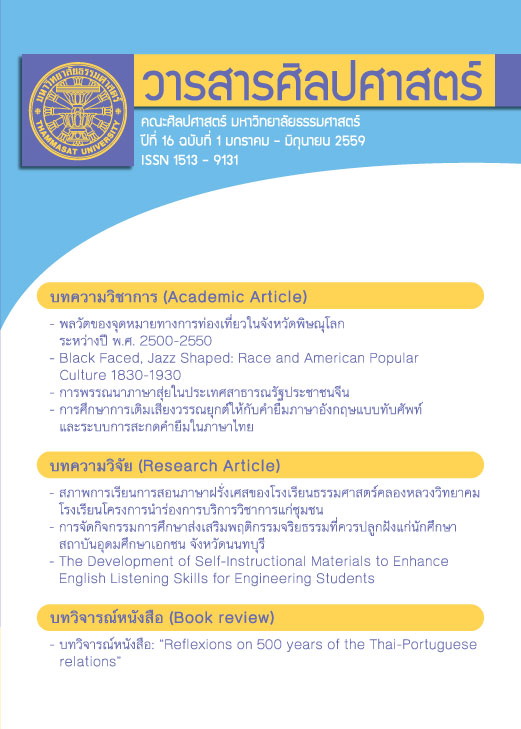การศึกษาการเติมเสียงวรรณยุกต์ให้กับคำยืมภาษาอังกฤษแบบทับศัพท์และระบบการสะกดคำยืมในภาษาไทย
Main Article Content
บทคัดย่อ
บทความนี้นำเสนอข้อสังเกตด้านเสียงวรรณยุกต์ในคำยืมภาษาอังกฤษในภาษาไทยจากหลักเกณฑ์การบัญญัติคำทับศัพท์ฯ โดยราชบัณฑิตยสถาน และจากผลการวิเคราะห์ ทางระบบเสียง รวมถึงข้อมูลเบื้องต้นจากแบบสำรวจผู้ใช้ภาษาและการคลังข้อมูลภาษา แนวคิดเรื่องการสะกดคำทับศัพท์ในภาษาไทยแบ่งได้เป็น 2 รูปแบบ คือ การบัญญัติจากการถอดตามเสียงที่ออก และจากการถอดอักษร ซึ่งการบัญญัติศัพท์จากการถอดอักษรนี้มิได้กล่าวเจาะจงเรื่องการกำกับเสียงวรรณยุกต์ ทั้งนี้การเติมเสียงวรรณยุกต์ในคำยืมจากภาษาที่ไม่มีเสียงวรรณยุกต์เป็นประเด็นที่นักภาษาศาสตร์ให้ความสนใจ และอาจกล่าวได้ว่าในภาษาที่มีเสียงวรรณยุกต์ รวมทั้งภาษาไทย การเติมเสียงวรรณยุกต์ในคำยืมจะเกิดขึ้นอย่างมีระบบและเป็นรูปแบบผลการศึกษาเบื้องต้นแสดงให้เห็นว่าคำทับศัพท์ที่มีการเติมเสียงวรรยุกต์ตรี มีแนวโน้มทำให้เกิดความสับสนในการใช้รูปวรรณยุกต์มากที่สุด และเสียงสามัญมีน้อยที่สุด การบัญญัติคำทับศัพท์ตามเกณฑ์การถอดอักษรอาจทำให้การกำหนดเสียงวรรณยุกต์ในการสะกดคำยืมจำนวนหนึ่งไม่สอดคล้องกับการออกเสียงโดยผู้ใช้ภาษา ส่งผลให้ผู้ใช้เกิดความสับสน โดยเฉพาะคำทับศัพท์ที่มีการเติมเสียงวรรณยุกต์โทและตรี เช่น โซลา (โท) แท็งก์ (ตรี) ที่มีการบัญญัติการกำกับวรรณยุกต์ที่ไม่ชัดเจน ทำให้เกิดการสะกดหลากหลายรูปแบบโดยผู้ใช้ภาษา ดังนั้น เพื่อให้เกิดแบบแผนชัดเจนและมีความสอดคล้องกับการใช้ ควรจัดให้มีการสำรวจการใช้ของคำเหล่านี้ควบคู่กับการวิเคราะห์โดยผู้เชี่ยวชาญทางภาษาเพื่อเป็นแนวทางในการสร้างแบบแผนสำหรับคำยืมภาษาอังกฤษและภาษาอื่นๆ
This paper provides some observations concerning Thai phonemic tone assignment in English loanwords based on various sources: the Royal Institute of Thailand's loanword rules and regulations, previous phonological analyses of the observed patterns, and our preliminary data collected from Thai informants and large-scale written corpora. For Thai, there are two general approaches for spelling English loanwords: using the closest alphabet equivalent and tone markers reflecting the actual pronunciation, and following transliteration/transcription systems sets for Thai, with no specifications for marking of assigned tones. It should be noted that phonemic tone assignment/adaptation of loan words from non-tonal languages has been a focus of linguistic research. By and large, it was found that tone assignment of loanwords in a tonal language (and also in the case of Thai) is consistent and systematic as it is shaped by the language's sound system and perceptual patterns. From our data, we found that loanwords with the assigned high tone tend to create the most inconsistent spelling patterns, and those with the assigned mid tone the least. The current transliteration systems, which in some cases create written forms of loanwords that do not match with the pronunciation, could lead to inconsistency and confusion among language users. Loanwords with the assigned falling tone or high tone, which according to the spelling systems are not required to have any tone markers, were found to have a large variety of spellings. To standardize the spelling system of tone assignment for English loanwords (and loanwords from other languages), and to make it compatible with current language use, it is recommended that language surveys, questionnaires, and linguistics research be implemented.

